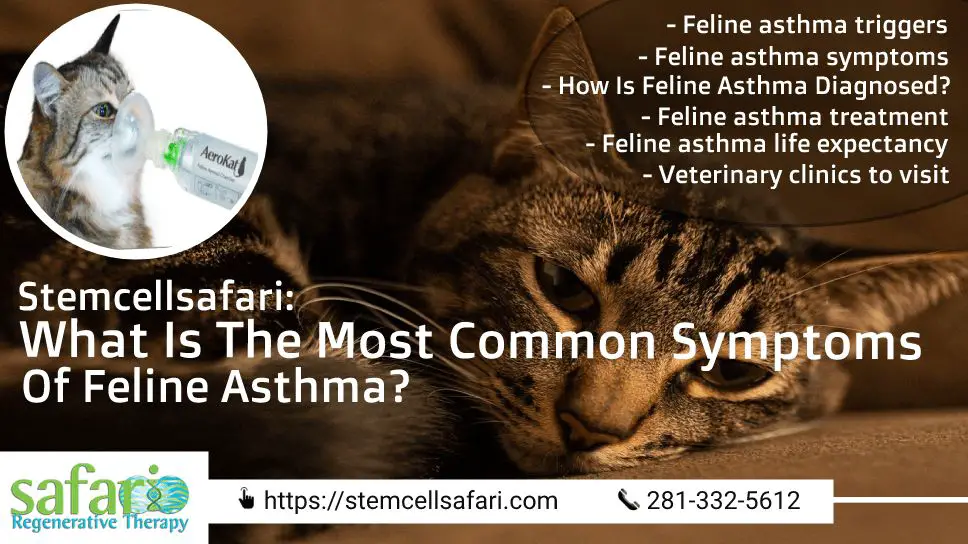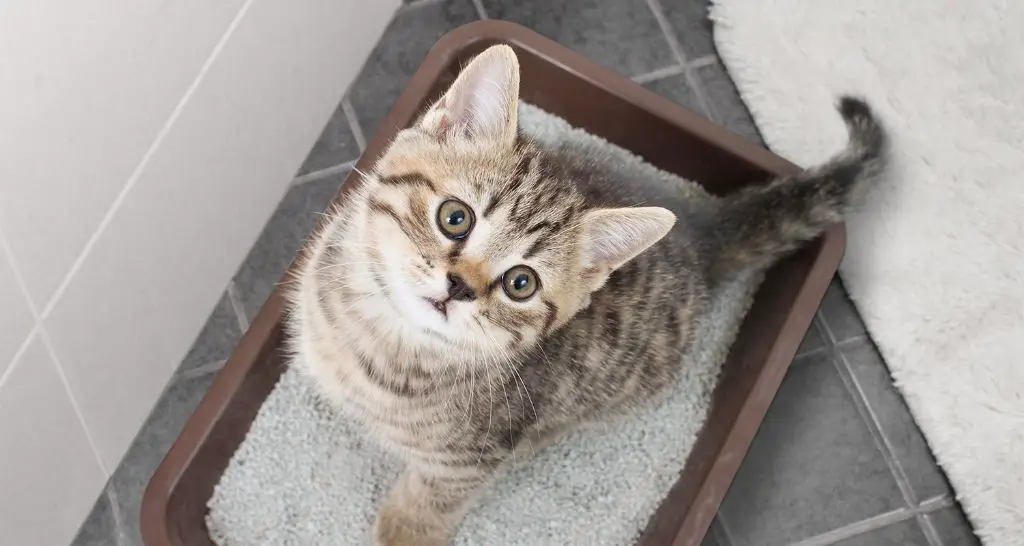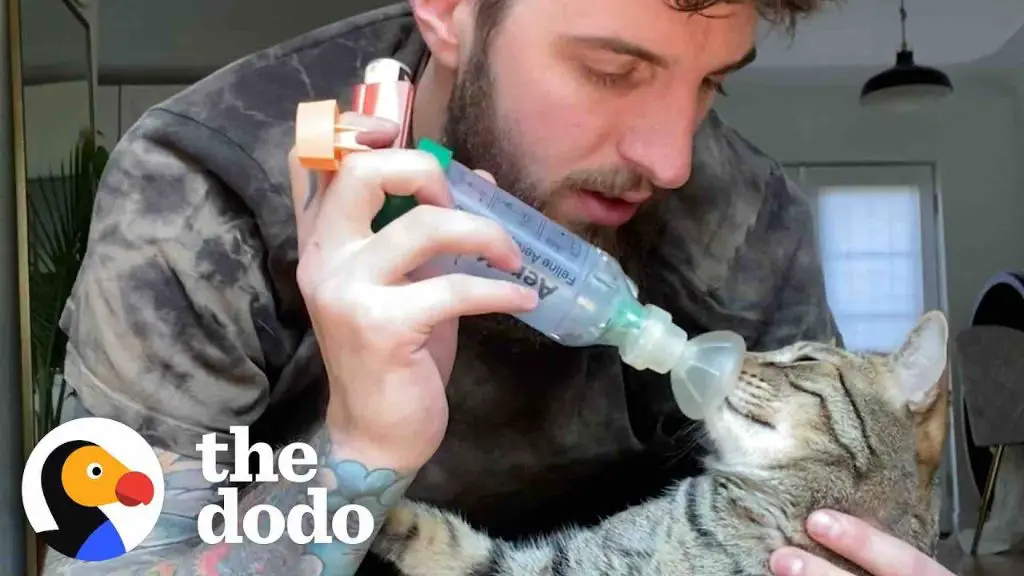What is Feline Asthma?
Feline asthma is a chronic respiratory disease affecting cats. It causes inflammation and narrowing of a cat’s bronchial airways, making it difficult for them to breathe (https://www.vet.cornell.edu/departments-centers-and-institutes/cornell-feline-health-center/health-information/feline-health-topics/feline-asthma-what-you-need-know).
Asthma is estimated to affect 1-5% of domestic cats in the United States, making it the most commonly diagnosed respiratory disorder in cats (https://www.vet.cornell.edu/departments-centers-and-institutes/cornell-feline-health-center/health-information/feline-health-topics/feline-asthma-risky-business-many-cats).
Common symptoms include coughing, wheezing, labored breathing, and breathing with an open mouth. Vets usually diagnose feline asthma based on medical history, physical exam findings, and chest x-rays.
Causes of Feline Asthma
There are several potential causes and contributing factors for feline asthma. Some of the most common include:

Allergies – Allergies to things like dust, pollen, mold, cigarette smoke, certain litter materials and other irritants are a frequent cause of asthma in cats. Inhaling these allergens triggers an immune response and inflammation in the airways. Cats with other allergic conditions like feline atopy are at higher risk. According to the Cornell Feline Health Center, identifying and avoiding allergy triggers is key for asthmatic cats (https://www.vet.cornell.edu/departments-centers-and-institutes/cornell-feline-health-center/health-information/feline-health-topics/feline-asthma-risky-business-many-cats).
Air Pollution – Pollutants in the air both indoors and outdoors can contribute to asthma flare-ups. Things like car exhaust, factory emissions, and cigarette smoke contain irritants that cats can inhale and react to. Keeping asthmatic cats indoors in an air-filtered environment can help.
Obesity – Being overweight puts extra pressure on a cat’s respiratory system. Excess body fat in the chest and abdomen area can physically restrict breathing over time. Helping an asthmatic cat lose weight reduces strain on the lungs.
Genetics – Just as in humans, there seems to be a genetic component to feline asthma risk. Some purebred cats like Siamese are predisposed. A cat with blood relatives who had asthma is more likely to develop it.
Conventional Asthma Treatments for Cats
Conventional treatment for feline asthma typically involves prescription medications such as corticosteroids, bronchodilators, antibiotics, and anti-inflammatories to reduce inflammation in the airways and improve breathing capacity. Corticosteroids like prednisolone are commonly prescribed to reduce inflammation. Bronchodilators such as terbutaline relax the airway muscles to open up the airways. Antibiotics may be used short-term to treat secondary infections that can exacerbate asthma symptoms. Anti-inflammatories like NSAIDs can provide additional anti-inflammatory effects.
According to the Cornell Feline Health Center, corticosteroids and bronchodilators are the most effective medications for managing feline asthma long-term [1]. Corticosteroids like prednisolone are typically the first-line treatment. Oral bronchodilators may also be prescribed. Inhaled medications delivered via nebulizer, such as terbutaline or fluticasone, are also commonly used. Most cats require 1-2 weeks of oral medications to control an initial asthma flare up before transitioning to inhaled medications according to VCA Hospitals [2].
While conventional medications can effectively manage asthma symptoms, they may cause side effects with long-term use. Working closely with your vet to find the optimal treatment regimen is important. Lifestyle and environmental changes can also help reduce asthma flare ups and medication needs.
Holistic and Natural Remedies
There are several natural remedies that may help relieve asthma symptoms in cats. These alternative treatments focus on reducing inflammation, strengthening the immune system, and alleviating allergies.

For overweight cats, losing excess weight can greatly improve breathing and reduce asthma flare-ups. Consult with your veterinarian about an appropriate weight loss plan involving diet and exercise [1].
Air purifiers with HEPA filters can remove allergens like dust, pollen, and dander from the air. Regularly changing HVAC filters can also help keep irritants at bay. Consider keeping your cat out of the bedroom, where human allergens concentrate at night [2].
Omega-3 fatty acid supplements derived from fish oil provide anti-inflammatory effects. Always consult your vet before starting supplements. Herbal remedies like ginger, turmeric, and boswellia may also reduce inflammation associated with feline asthma [3].
Acupuncture treatments may help open airways and regulate immune function. Some cats respond well to homeopathy for chronic conditions like asthma. As with any treatment, work closely with your vet to monitor your cat’s health.
Allergy Shots and Immunotherapy
Allergy shots, also known as allergen immunotherapy, can help reduce allergic reactions to cats for some people. This involves gradually exposing the immune system to small amounts of cat allergens like dander or saliva over time. The goal is to change the immune system’s response and build up tolerance to cat allergens.
During allergy testing, a person is exposed to small amounts of potential allergens like cat hair or dander on the skin or blood to determine what they are allergic to. Once the allergens are identified, a serum containing tiny doses of the allergens is created. This serum is then injected into the person receiving the allergy shots.[1]

The doses are gradually increased over the course of the treatment, which usually takes place over 3-5 years. Allergy shots have been shown to significantly reduce allergy symptoms and need for medication in many patients with cat allergies. One recent study found that a monoclonal antibody injection before allergy shots provided longer lasting effects.[2]
However, allergy shots come with some risks like any injection or medication. Potential side effects include itching, swelling, and redness at the injection site or more severe whole-body reactions. Allergy shots involve a commitment to frequent doctor’s visits for injections over an extended period of time. They may also be expensive depending on insurance coverage.
Environmental Changes
Making some changes to your cat’s environment can help reduce asthma attacks and flare-ups. One of the most important things is to reduce dust exposure. Dust contains many allergens and irritants that can trigger asthma symptoms in cats. Use high efficiency filters in heating and air systems and vacuum regularly with a HEPA filter vacuum to remove dust. Wash bedding frequently in hot water as well to remove dust mites. You can also use mattress and pillow covers to reduce dust buildup in your cat’s favorite sleeping spots.
Avoiding exposure to cigarette smoke is also very important. Secondhand smoke is highly irritating to the airways and will make asthma worse. Do not smoke around your cat and do not allow smoke back in on clothing or skin if you do smoke outside. Setting up a completely smoke-free home is ideal.
Monitoring litter boxes is also beneficial. Use dust-free, low tracking litters to reduce airborne particles. Scoop boxes frequently and change litter often to prevent buildup of ammonia fumes that can also irritate airways. Placing litter boxes in low-traffic areas and using boxes with hoods and filters can also help reduce respiratory irritants.
Can Inhalers Cure Feline Asthma?
Inhalers are one of the most common and effective treatments prescribed for cats with asthma. Inhalers work by delivering medication directly into a cat’s airways, providing fast relief by relaxing airway muscles, reducing inflammation, and opening airways. This makes breathing easier for asthmatic cats.
There are two main types of inhalers used for feline asthma: bronchodilators and corticosteroids. Bronchodilators provide quick relief by opening airways. Common bronchodilators used include albuterol and terbutaline. Corticosteroids reduce airway inflammation over time. Beclomethasone and fluticasone are corticosteroid medications often prescribed.
Benefits of inhalers include delivering medication right to the lungs, fast relief of symptoms, and avoiding systemic side effects. Drawbacks are the difficulty of administering medication to cats and the need for regular use to control symptoms. While extremely helpful, inhalers are not a cure for feline asthma. They are an effective management tool to control symptoms and improve quality of life when used consistently under veterinary guidance.
According to Dr. Trudell of Trudell Animal Health, “inhaled medications are a better option for treating cat asthma because the medication targets the airways directly, instead of needing to be absorbed through the stomach.” She recommends working closely with your vet to find the right inhaler and dose for your cat (source).
Is There a Cure?
Unfortunately there is no complete cure for feline asthma at this time. However, like with human asthma, the symptoms can be well-managed with proper treatment. While asthma cannot be cured in cats, the inflammation in the airways can be reduced and breathing difficulties can be minimized through conventional and holistic approaches.
With appropriate therapy, most cats with asthma go on to enjoy a good quality of life. Treatments aim to open up the airways, reduce inflammation, and prevent asthma attacks. This allows cats to breathe easier and partake in normal activities without respiratory distress.
According to Cornell University’s College of Veterinary Medicine, while feline asthma is incurable, “most cats respond well to treatment and can live normal, active lives.” Proper management of the disease allows cats to thrive and asthma symptoms can potentially go into remission for months or even years at a time.
The treatment goals for feline asthma are similar to human asthma treatment – control airway inflammation, dilate narrowed airways, and avoid triggers that can induce attacks. With the right combination of conventional medicine, natural remedies, and lifestyle adjustments, the symptoms of feline asthma can be controlled long-term.
Outlook and Prognosis
With proper management, cats with asthma can live happy and normal lives. However, asthma is a chronic condition that requires lifelong treatment and monitoring. Still, the long-term outlook for asthmatic cats is generally good as long as the disease is well controlled.
According to veterinary experts, the prognosis for a cat with well-managed asthma is quite favorable. With appropriate therapy like steroids and bronchodilators, the vast majority of cats with asthma achieve clinical remission from their symptoms and lead normal active lives. One study showed over 80% of cats with asthma had a positive response to treatment within 2 weeks. However, asthma is not curable and tends to be a lifelong condition in cats.
There are some potential complications that may affect prognosis in poorly controlled asthma. Repeated severe flare-ups can cause permanent lung damage over time. In rare cases, end-stage asthma can lead to respiratory failure, which can be fatal if not treated aggressively. Another risk is the side effects of long-term corticosteroid use like diabetes and kidney disease.
Overall, with attentive home monitoring and follow-up veterinary care, most cats with managed asthma have a very good long-term outcome. Their life expectancy is often normal or near-normal if the disease is kept under control.[1]
Living with an Asthmatic Cat
Caring for a cat with asthma requires diligence and careful monitoring. The key aspects of managing life with an asthmatic cat include:
Monitoring Breathing

Keep a close eye on your cat’s breathing and watch for signs of distress like open-mouth breathing, wheezing, or breathing with an abdominal effort. It’s important to recognize the early signs of an oncoming asthma attack. Track the frequency of coughing episodes or count respiratory rates. This can help identify triggers and determine if treatment adjustments are needed.[1]
Giving Medications
Administer prescribed medications like corticosteroids, bronchodilators, or inhalers as directed by your veterinarian. Giving medication consistently and on schedule is crucial for controlling asthma symptoms. Inform your vet if you have difficulties getting your cat to take medications.[2]
Avoiding Triggers
Pay attention to potential asthma triggers like dust, cigarette smoke, chemicals like air fresheners, perfumes, cleaning products, or fragrances in litter. Reduce exposure to irritants and allergens in the environment whenever possible.
Emergency Preparedness
Have an emergency action plan in case of a severe asthma attack. Keep medications and inhalers on hand. Know the warning signs requiring immediate veterinary care. Prepare a portable kit with medications, oxygen mask, and instructions.
